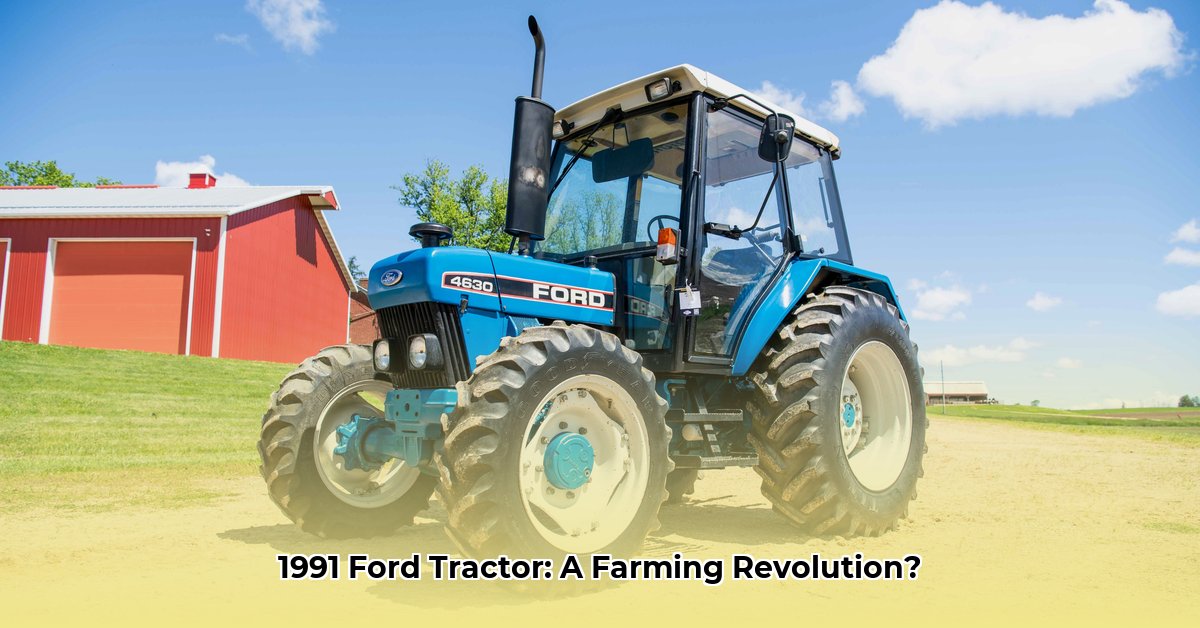
Remember those grainy family photos, the ones depicting Grandpa, weathered and proud, astride his trusty tractor? That image evokes a simpler time, a romanticized vision of American farming. While the tractor in those pictures might not be a 1991 Ford, that model represents a pivotal moment in agricultural history – a transition period rife with both remarkable advancements and unforeseen environmental consequences. This isn't just a story about metal and horsepower; it's a narrative about technology's profound impact on our food system and its complex relationship with sustainability. For more information on Ford tractor identification, check out this helpful serial number lookup tool.
A Giant's Shoulders: Ford and the Mechanization of Agriculture
Before the 1991 Ford tractor, farming was backbreaking toil. Imagine horses straining under heavy plows, yields meager compared to today's bounty, and human labor the dominant force. Ford's foray into agricultural machinery was nothing short of revolutionary. They didn't invent the tractor, but they dramatically altered its accessibility and impact. By streamlining production and lowering costs, Ford made mechanization a reality for countless family farms, fundamentally reshaping the American agricultural landscape. This era, while marked by increased efficiency, also initiated a complex conversation about the long-term sustainability of such practices. Did this increase in efficiency truly offset the potential environmental costs? That question remains critical.
The 1991 Ford Tractor: A Closer Look
The 1991 Ford tractor lineup wasn't a monolithic entity; it offered a diverse range of models, each tailored to specific farm sizes and needs. Think of it as choosing a car – some were smaller, more nimble machines for contained plots, while others were powerful, expansive field workhorses. A key improvement was enhanced fuel efficiency – a significant boon for farmers constantly battling rising fuel costs. These tractors were built for durability, engineered to withstand long hours and challenging conditions. Ultimately, they significantly boosted productivity through increased speed and operational efficiency.
| Feature | Description | Impact |
|---|---|---|
| Horsepower | Varied across models; options catered to different farm sizes. | Increased efficiency, scalability for larger farms. |
| Fuel Efficiency | Significant improvements over preceding models, reducing operational expenses. | Reduced fuel costs, potential for lower greenhouse gas emissions. |
| Maneuverability | Designs optimized for ease of operation in diverse terrains. | Greater precision, reduced time wasted on intricate tasks. |
| Reliability | Engineered for longevity and extended work hours. | Minimized downtime, maximizing overall productivity. |
Sustainability: A Double-Edged Plow
The environmental implications of the 1991 Ford tractor, however, are far more intricate than simple efficiency gains. While it undeniably increased farm output and reduced labor costs, the question of its overall environmental impact remains multifaceted. Did the efficiency gains outweigh the potential downsides of increased fuel consumption and soil compaction? Some studies suggest that larger tractors, even with fuel efficiency improvements, can compact soil, diminishing its fertility over time. Furthermore, increased agricultural output might have inadvertently fueled unsustainable farming practices. The complete picture is undeniably complex, and crucial research gaps remain. Further studies, specifically examining models like the 1991 Ford, are urgently needed to fully understand the long-term consequences.
The New Holland Legacy: A Path Towards Greener Farming
The Ford agricultural equipment division is now part of New Holland Agriculture, a pivotal moment signaling a significant industry shift. New Holland's current tractors feature advancements prioritizing sustainable agriculture. Precision farming technologies allow farmers to precisely target inputs (seeds, fertilizers), cutting waste and minimizing environmental impact. These modern machines show considerable improvements in fuel efficiency, aiming for a substantially smaller carbon footprint. This evolution demonstrates how lessons learned from past models, such as the 1991 Ford, continue to inform the development of environmentally conscious farming practices.
Actionable Steps: Building a Sustainable Future
The 1991 Ford tractor’s legacy serves as a potent reminder. To construct a truly sustainable agricultural future, we must prioritize:
Comprehensive Data Collection: Detailed data on the environmental impacts of older agricultural equipment is critical for benchmarking progress and setting future targets. This crucial data collection remains largely incomplete.
Technological Advancements: Continued investment in technological innovation, encompassing research into more efficient engines, alternative fuels, and even more precise farming technologies, remains essential for long-term sustainability.
Supportive Policy and Incentives: Governmental policies and incentives play a crucial role in encouraging farmers to adopt sustainable practices and technologies. Subsidies for purchasing eco-friendly equipment and tax breaks for sustainable farming methods could dramatically accelerate the transition.
Looking to the Future: Farming in Harmony with the Environment
The 1991 Ford tractor symbolizes both the remarkable progress and the inherent challenges of agricultural mechanization. This journey towards sustainability is not a linear progression; it's an iterative process of learning, adaptation, and continuous improvement. By acknowledging past patterns, embracing technological innovation, and establishing strong supportive policies, we can cultivate a future wherein farming practices are both economically viable and environmentally responsible. It's a shared responsibility, a collective endeavor requiring global collaboration and sustained research.